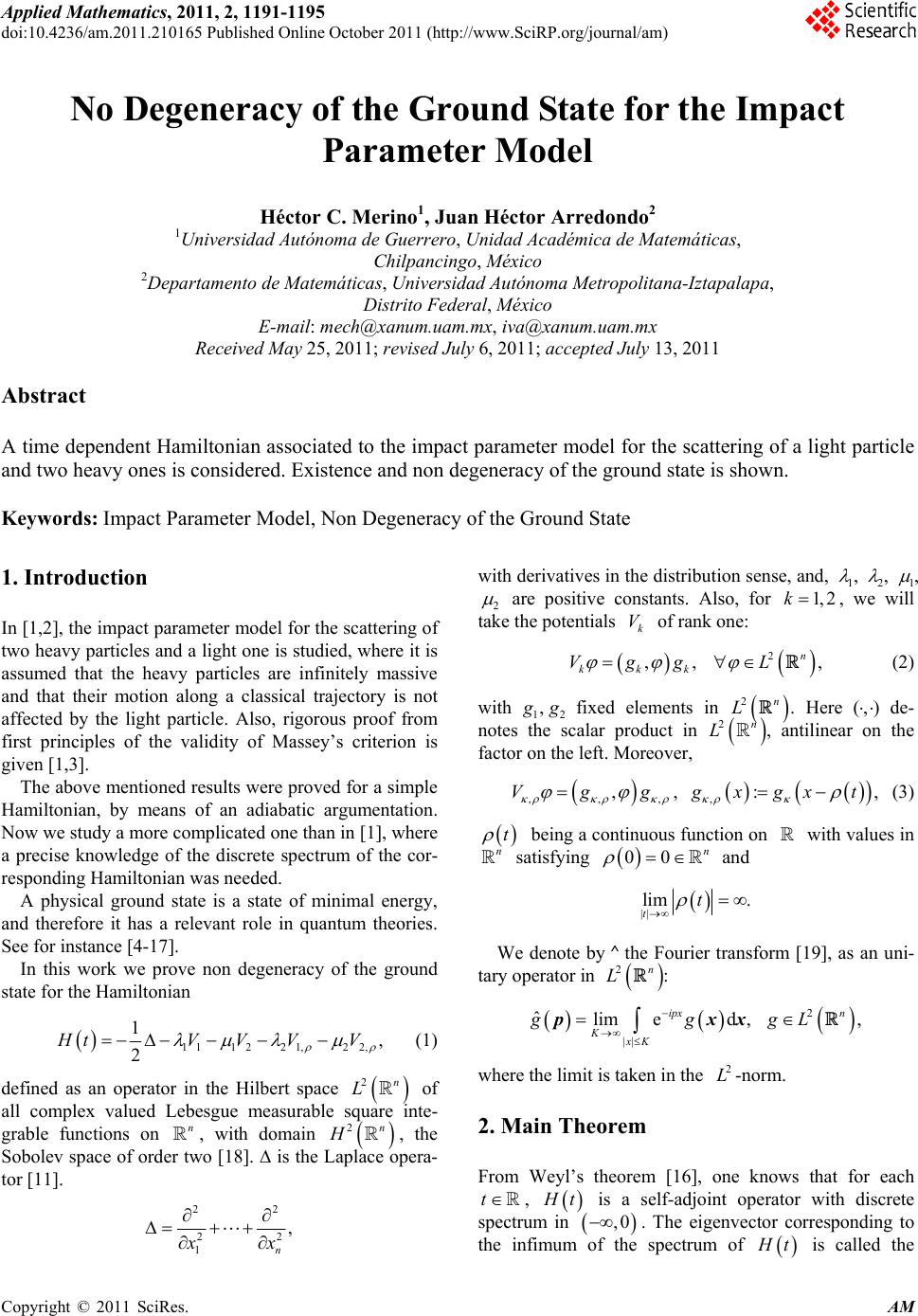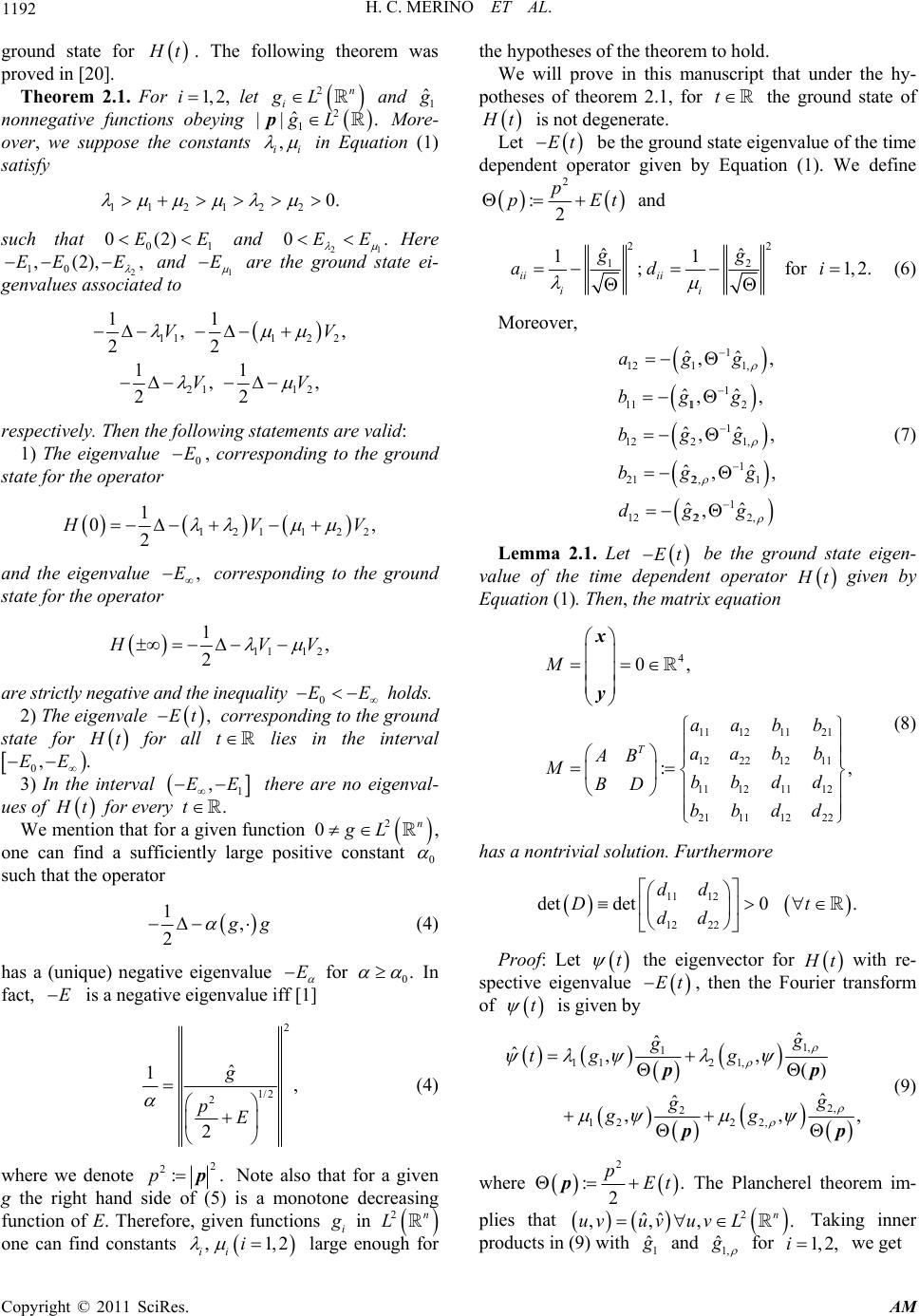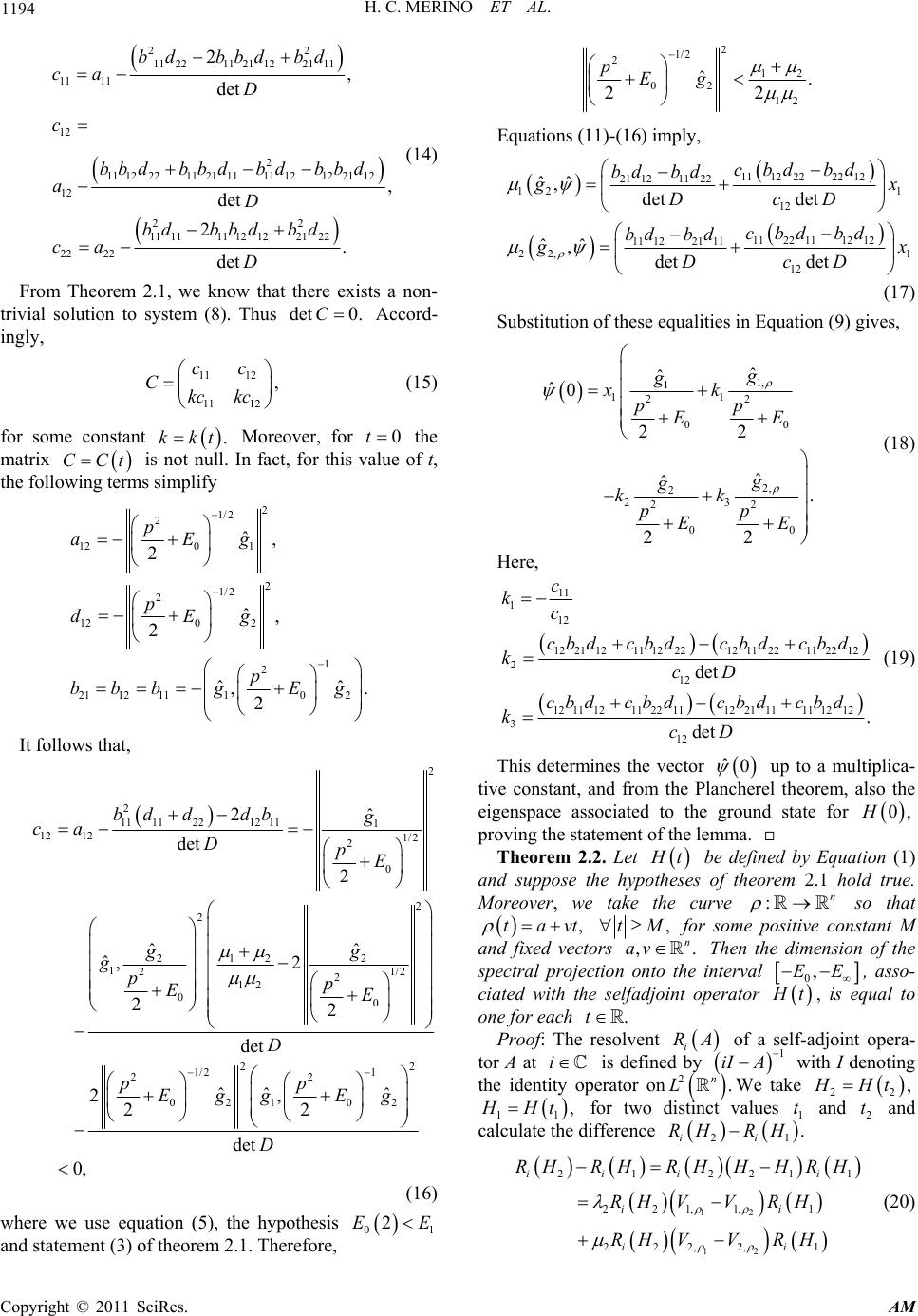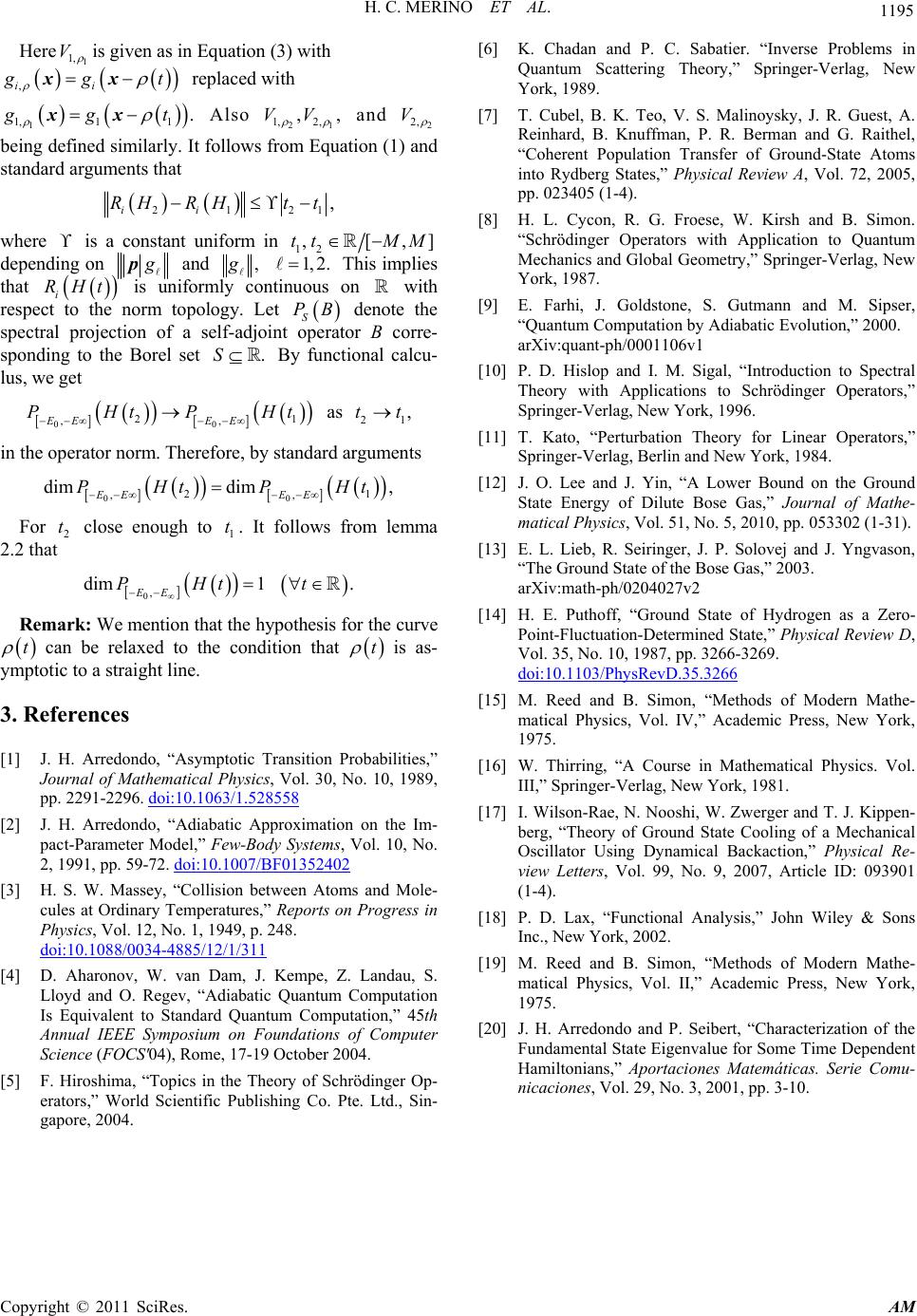 Applied Mathematics, 2011, 2, 1191-1195 doi:10.4236/am.2011.210165 Published Online October 2011 (http://www.SciRP.org/journal/am) Copyright © 2011 SciRes. AM No Degeneracy of the Ground State f or the Impac t Parameter Model Héctor C. Merino1, Juan Héctor Arredondo2 1Universida d A ut ó no ma de Guerrero , Unidad Académica de Matemáticas, Chilpancingo, México 2Departamento de Matemática s, Universidad Autónoma Metropo litana-Iztapalapa, Distrito Federal, México E-mail: mech@xanum.uam.mx, iva@xanum.uam.mx Received May 25, 201 1; revised July 6, 2011; accepted July 13, 2011 Abstract A time dependent Hamiltonian associated to the impact parameter model for the scattering of a light particle and two heavy ones is considered. Existence and non degeneracy of the ground state is shown. Keywords: Impact Parameter Model, Non Degeneracy of the Ground State 1. Introduction In [1,2], the impact parameter model for the scattering of two heavy particles and a light one is stud ied, where it is assumed that the heavy particles are infinitely massive and that their motion along a classical trajectory is not affected by the light particle. Also, rigorous proof from first principles of the validity of Massey’s criterion is given [1,3]. The above mentioned results were proved for a simple Hamiltonian, by means of an adiabatic argumentation. Now we study a more complicated one than in [1], where a precise knowledge of the discrete spectrum of the cor- responding Hamiltonian was needed. A physical ground state is a state of minimal energy, and therefore it has a relevant role in quantum theories. See for instance [4-17]. In this work we prove non degeneracy of the ground state for the Hamiltonian 111221,2 2, 1, 2 HtV VVV (1) defined as an operator in the Hilbert space 2n L 2n of all complex valued Lebesgue measurable square inte- grable functions on , with domain , the Sobolev space of order two [18]. is the Laplace opera- tor [11]. n H 22 22 1 , n x with derivatives in the distribution sense, and, 1 , 2 , 1 , 2 are positive constants. Also, for , we will take the potentials of ra nk one: 1, 2k k V ,, kk Vgg k 2, n L (2) with 12 , g fixed elements in 2n L. Here (,) de- notes the scalar product in 2n L, antilinear on the factor on the left. Moreover, ,, ,Vgg , , ,:, xgx t (3) t n being a continuous function on with values in satisfying 00 n and || lim . tt We denote by the Fourier transform [19], as an uni- tary operator in 2n L: || ˆlimed , ipx KxK gg px x 2, n gL where the limit is taken in the -norm. 2 L 2. Main Theorem From Weyl’s theorem [16], one knows that for each t , t is a self-adjoint operator with discrete spectrum in ,0 . The eigenvector corresponding to the infimum of the spectrum of t is called the  1192 H. C. MERINO ET AL. ground state for t i . The following theorem was proved in [20]. Theorem 2.1. For let and 1 1, 2, 2n i gL ˆ nonnegative functions obeying More- over, we suppose the constants 2 1 ˆ ||gL p , ii . in Equation (1) satisfy 11212 2 0. 0(2)E such that 0 and 21 1 EE 0.E Here 2 10 and 1 ,(EE2),E E, are the ground state ei- genvalues asso ciated to 11 0 E 12 2 21 12 11 ,, 22 11 ,, 22 VV VV respectively. Then the following statements are valid: 1) The eigenvalue , corresponding to the ground state for the operator 121 122 1 2 0, VV ,E and the eigenvalue corresponding to the ground state for the operator 11 12 1, 2 VV are strictly negative and the inequality 0 EE holds. 2) The eigenvale ,Et corresponding to the grou nd state for t for all lies in the interval t 0 3) In the interval ,EE . 1 there are no eigenval- ues of ,EE t for every . t We mention that for a given function 2 0, n gL 0 one can find a sufficiently large positive constant such that the operator 1, 2 g (4) has a (unique) negative eigenvalue E for 0. In fact, is a negative eigenvalue iff [1] E 2 1/2 2 ˆ 1, 2 g pE (4) where we denote 2 2:.pp Note also that for a given g the right hand side of (5) is a monotone decreasing function of E. Therefore, given functions i in 2n L one can find constants ,1,2i ii large enough for the hypotheses of the theorem to hold. We will prove in this manuscript that under the hy- potheses of theorem 2.1, for the ground state of t t is not degenerate. Let Et be the ground state eigenvalue of the time dependent operator given by Equation (1). We define 2 :2 p pEt and 22 1 ˆˆ 11 ; ii ii ii gg ad 2 for 1, 2.i (6) Moreover, 1 121 1, 1 11 112 1 122 1, 1 21 22, 1 1 12 222, ˆˆ ,, ˆˆ ,, ˆˆ , ˆˆ ,, ˆˆ , agg bgg bgg bgg dgg , (7) Lemma 2.1. Let Et be the ground state eigen- value of the time dependent operator t given by Equation (1). Then, the matrix equation 4 11 121121 1222 1211 11 121112 21 111222 0, :, T M aabb aabb AB Mbbdd BD bbdd x y (8) has a nontrivial solution. Furthermore 11 12 12 22 det det0 dd Ddd .t Proof: Let t the eigenvector for t with re- spective eigenvalue Et, then the Fourier transform of t is given by 1, 1 11 21, 2, 2 12 22, ˆ ˆ ˆ,, () ˆ ˆ ,,, g g tg g g g gg pp pp (9) where 2 :. The Plancherel theorem im- 2 pEtp plies that 2 ˆˆ ,,, n uvuvuv L 1 ˆ. Taking inner roducts in (9) with p and 1, ˆ for we get 1, 2,i Copyright © 2011 SciRes. AM  H. C. MERINO ET AL. Copyright © 2011 SciRes. AM 1193 2 11 1 1 111 21,11,121222,12, 2 1, 11 1,111,121,121, 222,1, 2, 2112 ˆ ˆˆ ˆˆˆ ˆˆ ˆˆˆˆˆˆˆˆˆ ,,,,,,,, , ˆ ˆˆˆˆˆ ˆˆˆˆˆˆˆˆˆ ˆˆ ,,,,, ,, ˆˆ ˆˆˆ ,,, g gg ggggggggg g ggggggggg gg ggg 1 , 2 11 1 2 121, 21,1222, 22, 2 2, 11 1 2,112, 121,2, 1,122,222, ˆ ˆˆˆ ˆˆ ˆˆˆˆˆˆ ,,,,, , ˆ ˆˆ ˆˆˆ ˆˆˆˆˆˆˆˆˆˆˆ ,,,,,,,,, g gg gggggg g ggggggggggg . (10) This system of equations is represented in matrix form precisely by Equation (8), wh ere 22 ˆˆ 11 gg 22 1/2 1/2 22 12 2 2, 22 22 ˆ ˆ, 2 E Rt pp EE g gpE 11 1 221, 12 1 222, ˆ ˆ, :; ˆ ˆ, ˆ ˆ, :ˆ ˆ, g x xg g y yg x y (11) From Theorem 2.1 we deduce the existence of a non- trivial solution to Equation (8). Now we fix For every t let us consider the function, 0.E and observe that for 0(2),EE 24 2 2 2, 12 2212 2 2 1/21/2 21/2 22 2 12 1212 12 2 122 1/2 2 1212 ˆ ˆˆ ˆ 11 ˆ, 2 22 2 ˆ 10. 2 E g gg g Rt gp pp p E EE g pE E (12) The last inequality being true because of the remark following Equation (5). Also, we have used the Schwarz inequality and the Fourier transform property 12112 1 022 VV is not degenerate. 2, 2 ˆˆ . it geg p pp When EEt is the ei- Proof: Lemma (2.1) assures that exists. Equa- tion (8) implies, 1 D genvalue for , t Et then the determinant of matrix D in Equation (8) satisfies, Theorem 2.1 states that det .DREt 0,E E and 10 2.EEE 0.D Then, (12) gives det 1,DB yx 1. T ABDB x0 (13) We take so that, 1 :, T CABDB The main result will be proved by showing that the dimension of the eigenspace associated to the ground sate remains constant over time. 11 12 12 22 , cc Ccc where Lema 2.2. The ground state for the operator  1194 H. C. MERINO ET AL. 22 11221121 1221 11 11 11 12 2 1112221121 1111 1212 21 12 12 22 11111112122122 22 22 2, det , det 2. det bdbbd bd ca D c bbdbbdbdbbd aD bdbbd bd ca D (14) From Theorem 2.1, we know that there exists a non- trivial solution to system (8). Thus Accord- ingly, det 0. C 11 12 11 12 , cc Ckc kc (15) for some constant Moreover, for .kkt0t the matrix is not null. In fact, for this value of t, the following terms simplify CCt 2 1/2 2 1201 2 1/2 2 1202 1 2 21 1211102 ˆ, 2 ˆ, 2 ˆˆ ,. 2 p aEg p dEg p bbbgE g It follows that, 2 2 11112212 111 12 121/2 2 0 2 2 212 2 121/2 2 12 00 22 1/2 1 22 021 02 2ˆ det 2 ˆˆ ˆ,2 22 det ˆˆ ˆ 2, 22 det 0, bd ddbg ca DpE gg gpp EE D pp EggEg D (16) where we use equation (5), the hypothesis 01 2EE and statement (3) of theorem 2.1. Therefore, 2 1/2 212 02 12 ˆ. 22 pEg Equations (11)-(16) imply, 11122222 12 21 121122 12 1 12 1122 1112 12 11 1221 11 22, 1 12 ˆ ˆ,det det ˆ ˆ,det det cbd bd bd bd x DcD cbd bd bd bd x DcD (17) Substitution of these equalities in Equation (9) gives, 1, 1 11 22 00 2, 2 23 22 00 ˆ ˆ ˆ0 22 ˆ ˆ. 22 g g xk pp EE g g kk pp EE (18) Here, 11 112 12211211 1222121122112212 212 1211 1211221112 21 11111212 312 det . det c kc cbd cbdcbdcbd kcD cbd cbdcbd cbd kcD (19) This determines the vector up to a multiplica- tive constant, and from the Plancherel theorem, also the eigenspace associated to the ground state for ˆ0 0,H proving the statement of the lemma. Theorem 2.2. Let t be defined by Equation (1) and suppose the hypotheses of theorem 2.1 hold true. Moreover, we take the curve so that :n ,tavt ,M , n t for some positive constant M and fixed vectors Then the dimension of the spectral projection onto the interval .av 0,EE , asso- ciated with the selfadjoint operator t, is equal to one for each .t Proof: The resolvent i of a self-adjoint opera- tor A at RA i is defined by with I denoting the identity operator on 1 A iI 2n L.We take 22 , Ht , 11 Ht for two distinct values and and calculate the difference 1 t2 t 21ii RH .RH 12 12 21 221 221,1, 1 222,2,1 iii i ii ii RHRHRH H HRH RH VVRH RH VVRH 1 (20) Copyright © 2011 SciRes. AM  H. C. MERINO ET AL. Copyright © 2011 SciRes. AM 1195 [6] K. Chadan and P. C. Sabatier. “Inverse Problems in Quantum Scattering Theory,” Springer-Verlag, New York, 1989. Here 1 1, V is given as in Equation (3) with ,ii g xxt replaced with 1 1,11. gt xx Also 21 1, 2, ,,VV 2 2, V and [7] T. Cubel, B. K. Teo, V. S. Malinoysky, J. R. Guest, A. Reinhard, B. Knuffman, P. R. Berman and G. Raithel, “Coherent Population Transfer of Ground-State Atoms into Rydberg States,” Physical Review A, Vol. 72, 2005, pp. 023405 (1-4). being defined similarly. It follows from Equation (1) and standard arguments that 212 , ii RHRHtt 1 where is a constant uniform in 12 ,[,tt MM] depending on p and , This implies that is uniformly continuous on with respect to the norm topology. Let denote the spectral projection of a self-adjoint operator B corre- sponding to the Borel set By functional calcu- lus, we get 1, 2. S PB t 1 i RH .S [8] H. L. Cycon, R. G. Froese, W. Kirsh and B. Simon. “Schrödinger Operators with Application to Quantum Mechanics and Global Geometry,” Springer-Verlag, New York, 1987. [9] E. Farhi, J. Goldstone, S. Gutmann and M. Sipser, “Quantum Computation by Adiabatic Evolution,” 2000. arXiv:quant-ph/0001106v1 [10] P. D. Hislop and I. M. Sigal, “Introduction to Spectral Theory with Applications to Schrödinger Operators,” Springer-Verlag, New York, 1996. 00 21 ,,EE EE PHtPHt as 21 ,tt [11] T. Kato, “Perturbation Theory for Linear Operators,” Springer-Verlag, Berlin and New York, 1984. in the operator norm. Therefore, by standard arguments 00 2 ,, dimdim , EE EE PHt PHt [12] J. O. Lee and J. Yin, “A Lower Bound on the Ground State Energy of Dilute Bose Gas,” Journal of Mathe- matical Physics, Vol. 51, No. 5, 2010, pp. 053302 (1-31). For 2 close enough to . It follows from lemma 2.2 that t1 t[13] E. L. Lieb, R. Seiringer, J. P. Solovej and J. Yngvason, “The Ground State of the Bose Gas,” 2003. arXiv:math-ph/0204027v2 0, dim 1 EE PHt .t [14] H. E. Puthoff, “Ground State of Hydrogen as a Zero- Point-Fluctuation-Determined State,” Physical Review D, Vol. 35, No. 10, 1987, pp. 3266-3269. doi:10.1103/PhysRevD.35.3266 Remark: We mention that the hypothesis for the curve t can be relaxed to the condition that t is as- ymptotic to a straight line. [15] M. Reed and B. Simon, “Methods of Modern Mathe- matical Physics, Vol. IV,” Academic Press, New York, 1975. 3. References [1] J. H. Arredondo, “Asymptotic Transition Probabilities,” Journal of Mathematical Physics, Vol. 30, No. 10, 1989, pp. 2291-2296. doi:10.1063/1.528558 [16] W. Thirring, “A Course in Mathematical Physics. Vol. III,” Springer-Verlag, New York, 1981. [17] I. Wilson-Rae, N. Nooshi, W. Zwerger and T. J. Kippen- berg, “Theory of Ground State Cooling of a Mechanical Oscillator Using Dynamical Backaction,” Physical Re- view Letters, Vol. 99, No. 9, 2007, Article ID: 093901 (1-4). [2] J. H. Arredondo, “Adiabatic Approximation on the Im- pact-Parameter Model,” Few-Body Systems, Vol. 10, No. 2, 1991, pp. 59-72. doi:10.1007/BF01352402 [3] H. S. W. Massey, “Collision between Atoms and Mole- cules at Ordinary Temperatures,” Reports on Progress in Physics, Vol. 12, No. 1, 1949, p. 248. doi:10.1088/0034-4885/12/1/311 [18] P. D. Lax, “Functional Analysis,” John Wiley & Sons Inc., New York, 2002. [19] M. Reed and B. Simon, “Methods of Modern Mathe- matical Physics, Vol. II,” Academic Press, New York, 1975. [4] D. Aharonov, W. van Dam, J. Kempe, Z. Landau, S. Lloyd and O. Regev, “Adiabatic Quantum Computation Is Equivalent to Standard Quantum Computation,” 45th Annual IEEE Symposium on Foundations of Computer Science (FOCS'04), Rome, 17-19 October 2004. [20] J. H. Arredondo and P. Seibert, “Characterization of the Fundamental State Eigenvalue for Some Time Dependent Hamiltonians,” Aportaciones Matemáticas. Serie Comu- nicaciones, Vol. 29, No. 3, 2001, pp. 3-10. [5] F. Hiroshima, “Topics in the Theory of Schrödinger Op- erators,” World Scientific Publishing Co. Pte. Ltd., Sin- gapore, 2004.
|